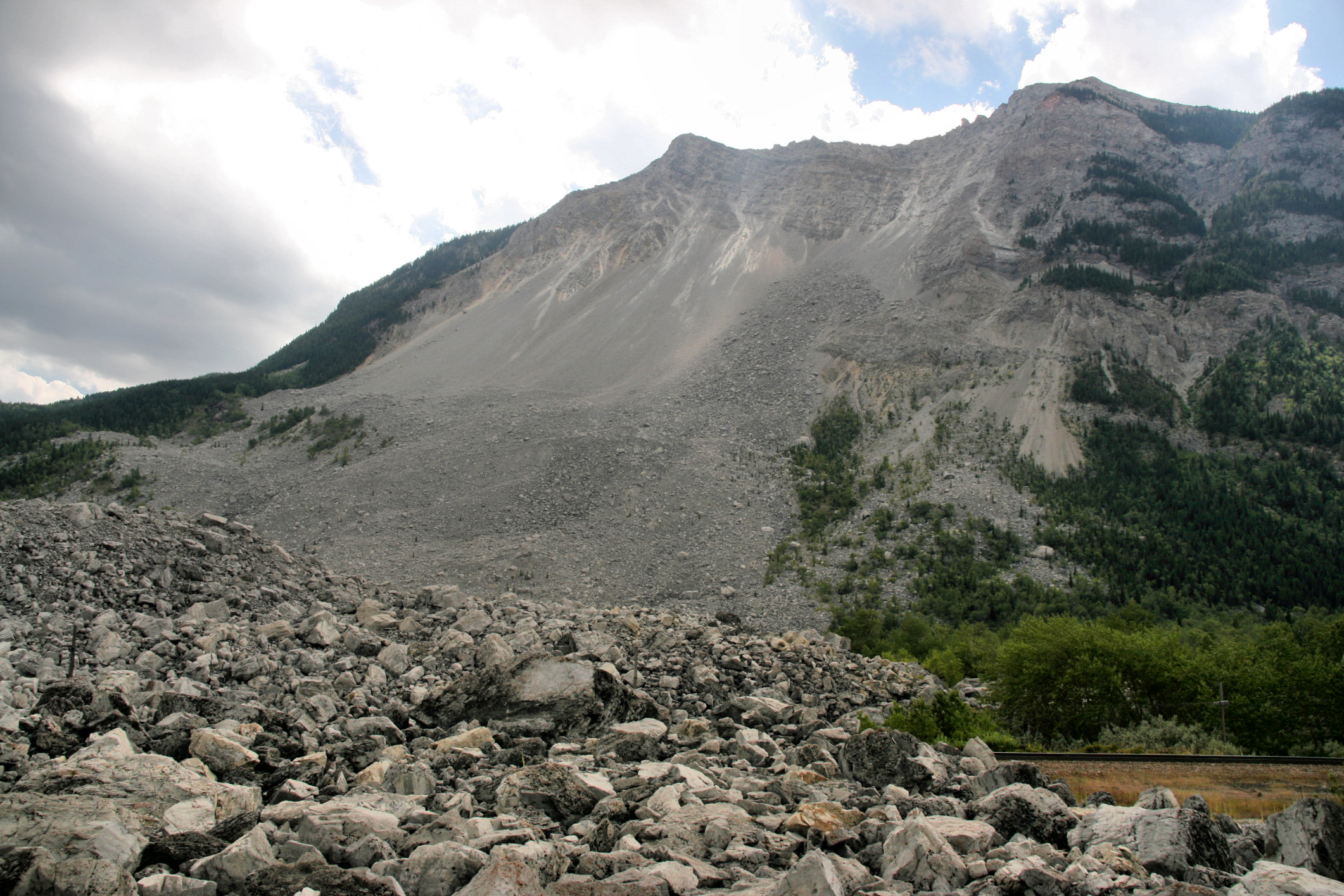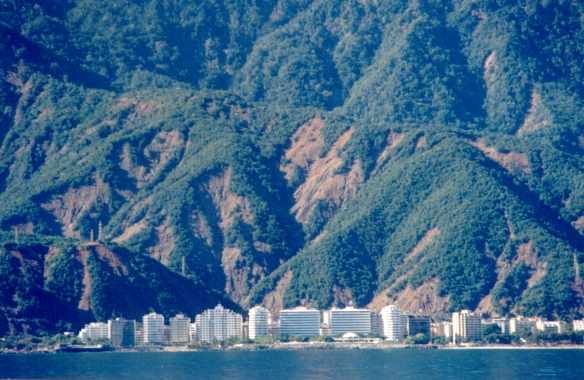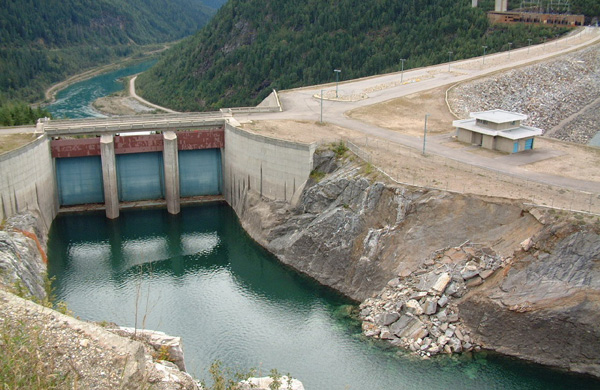|
Mudflows
A mudflow or mud flow is a form of mass wasting involving fast-moving flow of debris that has become liquified by the addition of water. Such flows can move at speeds ranging from 3 meters/minute to 5 meters/second. Mudflows contain a significant proportion of clay, which makes them more fluid than debris flows, allowing them to travel farther and across lower slope angles. Both types of flow are generally mixtures of particles with a wide range of sizes, which typically become sorted by size upon deposition. Mudflows are often called mudslides, a term applied indiscriminately by the mass media to a variety of mass wasting events. Mudflows often start as slides, becoming flows as water is entrained along the flow path; such events are often called flow slides. Other types of mudflows include lahars (involving fine-grained pyroclastic deposits on the flanks of volcanoes) and jökulhlaups (outbursts from under glaciers or icecaps). A statutory definition of "flood-related mudsli ... [...More Info...] [...Related Items...] OR: [Wikipedia] [Google] [Baidu] |
Debris Flow
Debris flows are geological phenomena in which water-laden masses of soil and fragmented rock rush down mountainsides, funnel into stream channels, entrain objects in their paths, and form thick, muddy deposits on valley floors. They generally have bulk densities comparable to those of rock avalanches and other types of landslides (roughly 2000 kilograms per cubic meter), but owing to widespread sediment liquefaction caused by high pore-fluid pressures, they can flow almost as fluidly as water. Debris flows descending steep channels commonly attain speeds that surpass 10 m/s (36 km/h), although some large flows can reach speeds that are much greater. Debris flows with volumes ranging up to about 100,000 cubic meters occur frequently in mountainous regions worldwide. The largest prehistoric flows have had volumes exceeding 1 billion cubic meters (i.e., 1 cubic kilometer). As a result of their high sediment concentrations and mobility, debris flows can be very des ... [...More Info...] [...Related Items...] OR: [Wikipedia] [Google] [Baidu] |
Lahar
A lahar (, from jv, ꦮ꧀ꦭꦲꦂ) is a violent type of mudflow or debris flow composed of a slurry of pyroclastic material, rocky debris and water. The material flows down from a volcano, typically along a river valley. Lahars are extremely destructive: they can flow tens of metres per second, they have been known to be up to deep, and large flows tend to destroy any structures in their path. Notable lahars include those at Mount Pinatubo and Nevado del Ruiz, the latter of which killed thousands of people in the town of Armero. Etymology The word ''lahar'' is of Javanese origin. Berend George Escher introduced it as a geological term in 1922. Description The word ''lahar'' is a general term for a flowing mixture of water and pyroclastic debris. It does not refer to a particular rheology or sediment concentration. Lahars can occur as normal stream flows (sediment concentration of less than 30%), hyper-concentrated stream flows (sediment concentration between 30 and 60% ... [...More Info...] [...Related Items...] OR: [Wikipedia] [Google] [Baidu] |
Sidoarjo Mud Flow
The Sidoarjo mud flow (commonly known as ''Lumpur Lapindo,'' wherein ''lumpur'' is the Indonesian word for mud) is the result of an erupting mud volcano in the subdistrict of Porong, Sidoarjo in East Java, Indonesia that has been in eruption since May 2006. It is the biggest mud volcano in the world; responsibility for it was credited to the blowout of a natural gas well drilled by PT Lapindo Brantas, although company officials contend it was caused by a very distant earthquake that occurred in a different province. At its peak it spewed up to of mud per day. By mid August 2011, mud was being discharged at a rate of per day, with 15 bubbles around its gushing point. This was a significant decline from the previous year, when mud was being discharged at a rate of per day with 320 bubbles around its gushing point. It is expected that the flow will continue for the next 25 to 30 years. Although the Sidoarjo mud flow has been contained by levees since November 2008, resultant ... [...More Info...] [...Related Items...] OR: [Wikipedia] [Google] [Baidu] |
List Of Landslides
This list of landslides is a list of notable landslides and mudflows divided into sections by date and type. This list is very incomplete as there is no central catalogue for landslides, although some for individual countries/areas do exist. Volumes of landslides are recorded in the scientific literature using cubic kilometres (km3) for the largest and millions of cubic metres (normally given the non-standard shortening of MCM) for most events. Prehistoric landslides Note: km3 = cubic kilometre(s) Submarine landslides Note: MCM = million cubic metres; km3 = cubic kilometre(s) Pre-20th-century historic landslides Note: km3 = cubic kilometre(s); MCM = million cubic metres 20th-century landslides 1901–1950 Note: km3 = cubic kilometre(s); MCM = million cubic metres 1951–1975 Note: km3 = cubic kilometre(s); MCM = million cubic metres 1976–2000 Note: MCM = million cubic metres 21st-century landslides 2001–2010 Note: m3 = cubic metre(s); MCM = million cubic metres 20 ... [...More Info...] [...Related Items...] OR: [Wikipedia] [Google] [Baidu] |
Debris
Debris (, ) is rubble, wreckage, ruins, litter and discarded garbage/refuse/trash, scattered remains of something destroyed, or, as in geology, large rock fragments left by a melting glacier, etc. Depending on context, ''debris'' can refer to a number of different things. The first apparent use of the French word in English is in a 1701 description of the army of Prince Rupert upon its retreat from a battle with the army of Oliver Cromwell, in England. Disaster In disaster scenarios, tornadoes leave behind large pieces of houses and mass destruction overall. This debris also flies around the tornado itself when it is in progress. The tornado's winds capture debris it kicks up in its wind orbit, and spins it inside its vortex. The tornado's wind radius is larger than the funnel itself. Tsunamis and hurricanes also bring large amounts of debris, such as Hurricane Katrina in 2005 and Hurricane Sandy in 2012. Earthquakes rock cities to rubble debris. Geological In geology, debri ... [...More Info...] [...Related Items...] OR: [Wikipedia] [Google] [Baidu] |
Vargas Tragedy
The Vargas tragedy was a natural disaster that occurred in Vargas State, Venezuela on 14–16 December 1999, when torrential rains caused flash floods and debris flows that killed tens of thousands of people, destroyed thousands of homes, and led to the complete collapse of the state's infrastructure. According to relief workers, the neighborhood of Los Corales was buried under of mud and a high percentage of homes were simply swept into the ocean. Entire towns including Cerro Grande and Carmen de Uria completely disappeared. As much as 10% of the population of Vargas died during the event. Background The coastal area of Vargas State has long been subject to mudslides and flooding. Deposits preserved on the alluvial fan deltas here show that geologically similar catastrophes have occurred with regularity since prehistoric times. Since the 17th century, at least two large-magnitude debris flow, landslide, or flood events, on average, have occurred each century within the modern ... [...More Info...] [...Related Items...] OR: [Wikipedia] [Google] [Baidu] |
Emergency Evacuation
Emergency evacuation is the urgent immediate egress or escape of people away from an area that contains an imminent threat, an ongoing threat or a hazard to lives or property. Examples range from the small-scale evacuation of a building due to a storm or fire to the large-scale evacuation of a city because of a flood, bombardment or approaching weather system, especially a tropical cyclone. In situations involving hazardous materials or possible contamination, evacuees may be decontaminated prior to being transported out of the contaminated area. Evacuation planning is an important aspect of business management of which emergency evacuation forms a part. Reasons for evacuation Evacuations may be carried out before, during, or after disasters such as: * Natural disasters ** Eruptions of volcanoes ** Tropical cyclones ** Floods ** Earthquakes ** Tsunamis ** Wildfires/Bushfires * Industrial accidents ** Chemical spill ** Nuclear accident * Transport ** Road accidents ** Tr ... [...More Info...] [...Related Items...] OR: [Wikipedia] [Google] [Baidu] |
Landslide
Landslides, also known as landslips, are several forms of mass wasting that may include a wide range of ground movements, such as rockfalls, deep-seated grade (slope), slope failures, mudflows, and debris flows. Landslides occur in a variety of environments, characterized by either steep or gentle slope gradients, from mountain ranges to coastal cliffs or even underwater, in which case they are called submarine landslides. Gravity is the primary driving force for a landslide to occur, but there are other factors affecting slope stability that produce specific conditions that make a slope prone to failure. In many cases, the landslide is triggered by a specific event (such as a heavy rainfall, an earthquake, a slope cut to build a road, and many others), although this is not always identifiable. Causes Landslides occur when the slope (or a portion of it) undergoes some processes that change its condition from stable to unstable. This is essentially due to a decrease in the She ... [...More Info...] [...Related Items...] OR: [Wikipedia] [Google] [Baidu] |
Washington (state)
Washington (), officially the State of Washington, is a state in the Pacific Northwest region of the Western United States. Named for George Washington—the first U.S. president—the state was formed from the western part of the Washington Territory, which was ceded by the British Empire in 1846, by the Oregon Treaty in the settlement of the Oregon boundary dispute. The state is bordered on the west by the Pacific Ocean, Oregon to the south, Idaho to the east, and the Canadian province of British Columbia to the north. It was admitted to the Union as the 42nd state in 1889. Olympia is the state capital; the state's largest city is Seattle. Washington is often referred to as Washington state to distinguish it from the nation's capital, Washington, D.C. Washington is the 18th-largest state, with an area of , and the 13th-most populous state, with more than 7.7 million people. The majority of Washington's residents live in the Seattle metropolitan area, the center of trans ... [...More Info...] [...Related Items...] OR: [Wikipedia] [Google] [Baidu] |
Landslide Classification
There have been known various classifications of landslides. Broad definitions include forms of mass movement (geology), mass movement that narrower definitions exclude. For example, the ''McGraw-Hill Encyclopedia of Science and Technology'' distinguishes the following types of landslides: *fall (by undercutting) *fall (by toppling) *Slump (geology), slump *rockslide *earthflow *sinkholes, mountain side *rockslide that develops into rock avalanche Influential narrower definitions restrict landslides to slumps and translational slides in rock and regolith, not involving fluidisation. This excludes falls, topples, lateral spreads, and mass flows from the definition.Varnes D. J., Slope movement types and processes. In: Schuster R. L. & Krizek R. J. Ed., Landslides, analysis and control. Transportation Research Board Sp. Rep. No. 176, Nat. Acad. oi Sciences, pp. 11–33, 1978.Hungr O, Evans SG, Bovis M, and Hutchinson JN (2001) Review of the classification of landslides of the flow type ... [...More Info...] [...Related Items...] OR: [Wikipedia] [Google] [Baidu] |
1980 Eruption Of Mount St
__NOTOC__ Year 198 (CXCVIII) was a common year starting on Sunday (link will display the full calendar) of the Julian calendar. At the time, it was known as the Year of the Consulship of Sergius and Gallus (or, less frequently, year 951 ''Ab urbe condita''). The denomination 198 for this year has been used since the early medieval period, when the Anno Domini calendar era became the prevalent method in Europe for naming years. Events By place Roman Empire *January 28 **Publius Septimius Geta, son of Septimius Severus, receives the title of Caesar. **Caracalla, son of Septimius Severus, is given the title of Augustus. China *Winter – Battle of Xiapi: The allied armies led by Cao Cao and Liu Bei defeat Lü Bu; afterward Cao Cao has him executed. By topic Religion * Marcus I succeeds Olympianus as Patriarch of Constantinople (until 211). Births * Lu Kai (or Jingfeng), Chinese official and general (d. 269) * Quan Cong, Chinese general and advisor (d. ... [...More Info...] [...Related Items...] OR: [Wikipedia] [Google] [Baidu] |








